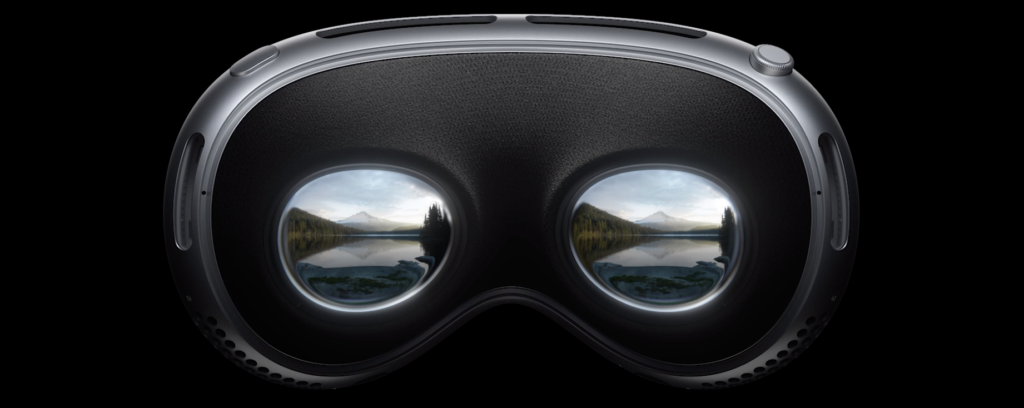Apple, the technology giant, recently announced its entry into Virtual Reality through the Apple Vision Pro. This mixed reality headset, currently in development, is bursting with potential, particularly in terms of accelerating adoption of the metaverse. In this article, we’ll discuss five key ways Vision Pro can become the catalyst the metaverse needs.
1. Technological features
The Vision Pro is packed innovative technologies designed to provide a highly immersive user experience. It features an ultra-high resolution display system that serves each eye with more pixels than a 4K TV, courtesy of 23 million of them spread over two screens.
Complementing this visual spectacle is the R1 chip, which provides a virtually lag-free, real-time worldview. With these advanced technologies, Apple’s Vision Pro will deliver an unparalleled metaverse experience, making the virtual universe more engaging and encouraging more users to step into this new frontier.

2. Integration with the Apple ecosystem
A crucial factor in adopting new technology is ease of use and integration with existing ecosystems. Apple’s Vision Pro is expected to integrate with its wide range of devices, such as the iPhone, iPad and Mac. Its compatibility with a wide variety of Apple apps, including FaceTime, Safari, and Messages, extends its functionality beyond the metaverse, making it an invaluable tool for everyday use. This integration could significantly accelerate metaverse adoption by providing users with a familiar interface and environment.
The wider adoption of virtual reality (VR) continues to face a handful of challenges. First, the resolution in today’s VR headsets is low, making it difficult to visualize small details in the virtual world. Second, latency – the delay between user actions and their reflections in the VR environment – can lead to motion sickness or feelings of disconnection. In addition, these headsets are often quite heavy, which can become uncomfortable during prolonged use.

3. Various applications
A driving factor in metaverse adoption is its wide range of possible applications. The Vision Pro opens up possibilities far beyond gaming and immersive virtual reality experiences. The headset is expected to become a powerful tool in augmented reality, merging digital content with the real world. In addition, its potential applications in business for training, presentations and collaboration, as well as in education for learning, research and simulations, make it an attractive proposition. This wide range of use cases will make the metaverse more appealing to different industries, accelerating overall adoption.
We are already witnessing innovative uses for the metaverse, marking the arrival of a new digital revolution. Several institutions are leveraging the power of virtual reality for remote learning and virtual healthcare, demonstrating the metaverse’s transformative potential. Nevertheless, momentum needs a major boost, and this is where Apple’s role could become critical.
4. Apple’s brand influence
The power of the Apple brand cannot be underestimated. A new product announcement from Apple invariably generates global attention and excitement. As the Vision Pro makes its debut, it brings with it the credibility and user trust of the brand. This recognition can play a critical role in driving metaverse adoption, as users are more likely to explore a metaverse offering from a brand they trust and admire.
In a recent Fortune ranking, Apple secured its position as the most valued company in the world, surpassing Amazon and Microsoft, which followed in the top three. This marks the 16th consecutive year that the maker of the iPhone has topped the list, continuously setting the benchmark for corporate admiration.

5. Apple’s commitment to the metaverse
Apples commitment to the metaverse is in its early stages and we are still waiting for a clearer picture. With its continued innovation and investment history, Apple could introduce other metaverse-oriented products. As a major player in the space, Apple’s activities could significantly influence the growth and evolution of the metaverse, accelerating its adoption by making it a mainstream technology.
Historically, Apple has consistently acted as a catalyst in transforming our world. An example of this power lies in smartphones. Before the introduction of the iPhone, smartphones were considered specialized tools, exclusively for business users and technology enthusiasts. But with the sleek design and user-friendly interface of the iPhone, Apple was able to penetrate a wider market, effectively mainstreaming smartphone use worldwide.
Final thoughts
Apple’s Vision Pro is more than just a portal to the metaverse. With its innovative technologies, diverse applications, and integration with the Apple ecosystem, backed by the strength of the Apple brand and commitment to the metaverse, it has the potential to be a major driver in adopting the metaverse. As we await launch, it’s clear that the Vision Pro could redefine our interaction with technology and shape the future of the metaverse.
The iPhone’s touchscreen interface offered a more intuitive and accessible experience than its predecessors. This innovation broadened the demographics of tech users and set a new standard for modern technology interaction. Could the same thing happen with Apple’s Vision Pro and the Metaverse? Time will tell, as the Apple Vision Pro should be released in 2024.
